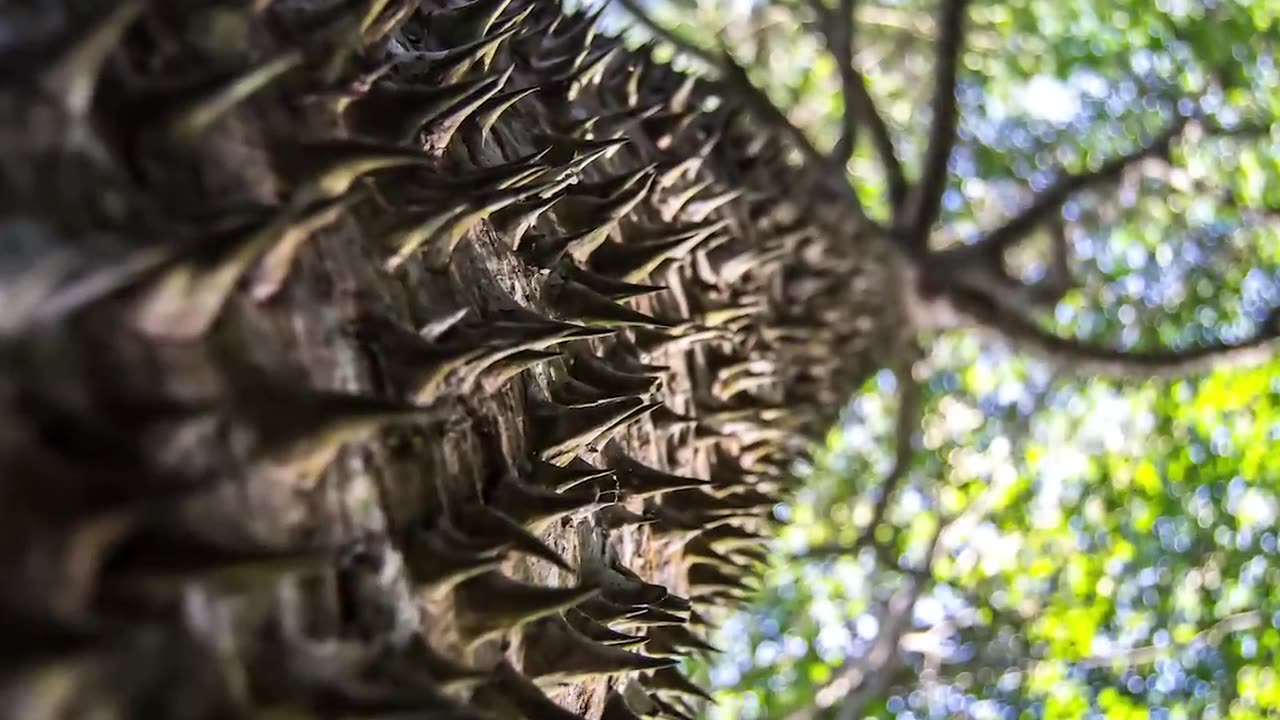Premium Only Content

Most dangerous tree you should never touch- #unknown #facts
#1. The Manchineel Tree Florida (The Most Dangerous Trees)
The Manchineel is a rare tropical plant that grows in sandy soils within northern South America and the Caribbean. You will find some traces in Central America, but its recognized habitat is in South Florida.
Woman fleeing from dangerous trees and scared of a Machineel tree with a danger warning sign in front showing the deadliest tree in the world.
Florida ranks highest in the most dangerous trees list, but other states in Northern America also have some poisonous tree species.
Unfortunately, most toxic trees look nothing different from harmless ones, so it’s very important to be able to recognize the dangerous trees when you see them.
This guide outlines 5 of the most deadly trees, how to identify them, and how to remove them safely, if required.
As much as these trees make the world beautiful, and some are useful to human beings, they can also be fatal. Below is a list of some of the most dangerous trees in the world.
#1. The Manchineel Tree Florida (The Most Dangerous Trees)
The Manchineel is a rare tropical plant that grows in sandy soils within northern South America and the Caribbean. You will find some traces in Central America, but its recognized habitat is in South Florida.
Manchineel Tree showing its leaves, flower spikes, and apple-like fruits.
The tree is also ranked in the Guinness Book of World Records (2011) as the most dangerous tree in the world
Why Is the Manchineel Tree Dangerous?
All Manchineel tree parts are dangerous to humans, including their bark and leaves. The tree has a sweet apple-like fruit that can cause internal bleeding, edema, and shock when consumed.
The tree also has a poisonous milky sap that causes burning and blistering when in contact with the human body.
Manchineel Tree Poison Symptoms
Once you have touched or consumed the Manchineel tree fruits, you will start experiencing extreme pain, blisters, or even death. Even the smoke that is produced when burning the limbs and leaves can cause blindness, skin irritation and other problems.
How To Get Rid of Manchineel Trees (Get Rid of Dangerous Trees)
Due to the toxic nature of the Manchineel plant, you should never try to remove it from your yard without professional help. Any contact with the plant could be fatal unless you know how to handle the plant safely.
Contact a professional to help you remove a Manchineel tree near your home. Reach out to local businesses that know how to kill a tree without cutting it down, or that offer free tree removal programs.
Manchineel Tree Locations (Manchineel Tree Florida: Map of Locations)
Manchineel trees are located in the northern parts of South America, the Caribbean, and a bit of Central America. However, most of the surviving Manchineel trees are in Florida and Mexico.
You might not find the trees in public parks and common areas, but you might encounter them in forests and nature trails in Florida.
Florida ranks top in the states with the highest number of Manchineel trees.3
Manchineel Tree Burns
The Manchineel tree produces toxic smoke that could cause blindness when you stand too close to it.It’s also not a good idea to breathe the smoke.
Additionally, the sap from the tree causes burns to the skin and could lead to inflammation and rashes.
Manchineel Tree Identification (What Does the Manchineel Tree Look Like?)
Manchineel tree is a rare tree species. Even in Florida, where it grows, you can only find it in the Everglades and the Florida Keys.
But, it’s still a good idea to keep an eye out for it. Key characteristics to look for include he fruit, flowers, bark, and leaves of the tree.
Manchineel Tree Identification Chart showing images of Manchineel tree leaves, manchineel tree fruit, and manchineel tree bark.
The Manchineel Tree Identification Chart shows them above.
#2. Namibian Bottle Tree (A Killer Tree in Africa)
The Namibian Bottle tree is a desert tree that is shaped like a bottle to hold water for the tree. However, that water is highly poisonous and fatal to animals and humans. Hunters use the water for hunting game.
The toxic water is a defense mechanism against desert animals that would otherwise consume all the water leaving the plant to die. This tree also has thorny branches to keep it safe from anyone trying to destroy it. The good thing about the plant is that you will not find it in most human habitats.
It is designed for the desert and has such a distinct shape that it would be hard to miss it. It is also mostly found in Namibia, Africa, meaning that you might never come across the tree in your lifetime.
Woman fleeing from dangerous trees and scared of a Machineel tree with a danger warning sign in front showing the deadliest tree in the world.
Florida ranks highest in the most dangerous trees list, but other states in Northern America also have some poisonous tree species.
Unfortunately, most toxic trees look nothing different from harmless ones, so it’s very important to be able to recognize the dangerous trees when you see them.
This guide outlines 15 of the most deadly trees, how to identify them, and how to remove them safely, if required.
As much as these trees make the world beautiful, and some are useful to human beings, they can also be fatal. Below is a list of some of the most dangerous trees in the world.
#1. The Manchineel Tree Florida (The Most Dangerous Trees)
The Manchineel is a rare tropical plant that grows in sandy soils within northern South America and the Caribbean. You will find some traces in Central America, but its recognized habitat is in South Florida.
Manchineel Tree showing its leaves, flower spikes, and apple-like fruits.
The tree is also ranked in the Guinness Book of World Records (2011) as the most dangerous tree in the world.2
Why Is the Manchineel Tree Dangerous?
All Manchineel tree parts are dangerous to humans, including their bark and leaves. The tree has a sweet apple-like fruit that can cause internal bleeding, edema, and shock when consumed.
The tree also has a poisonous milky sap that causes burning and blistering when in contact with the human body.
Manchineel Tree Poison Symptoms
Once you have touched or consumed the Manchineel tree fruits, you will start experiencing extreme pain, blisters, or even death. Even the smoke that is produced when burning the limbs and leaves can cause blindness, skin irritation and other problems.
How To Get Rid of Manchineel Trees (Get Rid of Dangerous Trees)
Due to the toxic nature of the Manchineel plant, you should never try to remove it from your yard without professional help. Any contact with the plant could be fatal unless you know how to handle the plant safely.
Contact a professional to help you remove a Manchineel tree near your home. Reach out to local businesses that know how to kill a tree without cutting it down, or that offer free tree removal programs.
Manchineel Tree Locations (Manchineel Tree Florida: Map of Locations)
Manchineel trees are located in the northern parts of South America, the Caribbean, and a bit of Central America. However, most of the surviving Manchineel trees are in Florida and Mexico.
You might not find the trees in public parks and common areas, but you might encounter them in forests and nature trails in Florida.
Florida ranks top in the states with the highest number of Manchineel trees.3
Manchineel Tree Burns
The Manchineel tree produces toxic smoke that could cause blindness when you stand too close to it.It’s also not a good idea to breathe the smoke.
Additionally, the sap from the tree causes burns to the skin and could lead to inflammation and rashes.
Manchineel Tree Identification (What Does the Manchineel Tree Look Like?)
Manchineel tree is a rare tree species. Even in Florida, where it grows, you can only find it in the Everglades and the Florida Keys.
But, it’s still a good idea to keep an eye out for it. Key characteristics to look for include he fruit, flowers, bark, and leaves of the tree.
Manchineel Tree Identification Chart showing images of Manchineel tree leaves, manchineel tree fruit, and manchineel tree bark.
The Manchineel Tree Identification Chart shows them above.
#2. Namibian Bottle Tree (A Killer Tree in Africa)
The Namibian Bottle tree is a desert tree that is shaped like a bottle to hold water for the tree. However, that water is highly poisonous and fatal to animals and humans. Hunters use the water for hunting game.
The toxic water is a defense mechanism against desert animals that would otherwise consume all the water leaving the plant to die. This tree also has thorny branches to keep it safe from anyone trying to destroy it. The good thing about the plant is that you will not find it in most human habitats.
It is designed for the desert and has such a distinct shape that it would be hard to miss it. It is also mostly found in Namibia, Africa, meaning that you might never come across the tree in your lifetime.
#3. The Eastern Cottonwood
Eastern Cottonwood is a large tree with weak wood and deep roots.4 The tree grows in lowland areas and along streams, allowing it to grow very fast.
#4. The Sandbox Tree
The Sandbox tree is also known as the dynamite tree because its large pods explode and drop bulky seeds at a very high speed. The trees grow to about 200 feet above the ground, which makes the dropping seeds quite dangerous to anything beneath the tree.
Woman fleeing from dangerous trees and scared of a Machineel tree with a danger warning sign in front showing the deadliest tree in the world.
Florida ranks highest in the most dangerous trees list, but other states in Northern America also have some poisonous tree species.
Unfortunately, most toxic trees look nothing different from harmless ones, so it’s very important to be able to recognize the dangerous trees when you see them.
This guide outlines 15 of the most deadly trees, how to identify them, and how to remove them safely, if required.
As much as these trees make the world beautiful, and some are useful to human beings, they can also be fatal. Below is a list of some of the most dangerous trees in the world.
#1. The Manchineel Tree Florida (The Most Dangerous Trees)
The Manchineel is a rare tropical plant that grows in sandy soils within northern South America and the Caribbean. You will find some traces in Central America, but its recognized habitat is in South Florida.
Manchineel Tree showing its leaves, flower spikes, and apple-like fruits.
The tree is also ranked in the Guinness Book of World Records (2011) as the most dangerous tree in the world.2
Why Is the Manchineel Tree Dangerous?
All Manchineel tree parts are dangerous to humans, including their bark and leaves. The tree has a sweet apple-like fruit that can cause internal bleeding, edema, and shock when consumed.
The tree also has a poisonous milky sap that causes burning and blistering when in contact with the human body.
Manchineel Tree Poison Symptoms
Once you have touched or consumed the Manchineel tree fruits, you will start experiencing extreme pain, blisters, or even death. Even the smoke that is produced when burning the limbs and leaves can cause blindness, skin irritation and other problems.
How To Get Rid of Manchineel Trees (Get Rid of Dangerous Trees)
Due to the toxic nature of the Manchineel plant, you should never try to remove it from your yard without professional help. Any contact with the plant could be fatal unless you know how to handle the plant safely.
Contact a professional to help you remove a Manchineel tree near your home. Reach out to local businesses that know how to kill a tree without cutting it down, or that offer free tree removal programs.
Manchineel Tree Locations (Manchineel Tree Florida: Map of Locations)
Manchineel trees are located in the northern parts of South America, the Caribbean, and a bit of Central America. However, most of the surviving Manchineel trees are in Florida and Mexico.
You might not find the trees in public parks and common areas, but you might encounter them in forests and nature trails in Florida.
Florida ranks top in the states with the highest number of Manchineel trees.3
Manchineel Tree Burns
The Manchineel tree produces toxic smoke that could cause blindness when you stand too close to it.It’s also not a good idea to breathe the smoke.
Additionally, the sap from the tree causes burns to the skin and could lead to inflammation and rashes.
Manchineel Tree Identification (What Does the Manchineel Tree Look Like?)
Manchineel tree is a rare tree species. Even in Florida, where it grows, you can only find it in the Everglades and the Florida Keys.
But, it’s still a good idea to keep an eye out for it. Key characteristics to look for include he fruit, flowers, bark, and leaves of the tree.
Manchineel Tree Identification Chart showing images of Manchineel tree leaves, manchineel tree fruit, and manchineel tree bark.
The Manchineel Tree Identification Chart shows them above.
#2. Namibian Bottle Tree (A Killer Tree in Africa)
The Namibian Bottle tree is a desert tree that is shaped like a bottle to hold water for the tree. However, that water is highly poisonous and fatal to animals and humans. Hunters use the water for hunting game.
The toxic water is a defense mechanism against desert animals that would otherwise consume all the water leaving the plant to die. This tree also has thorny branches to keep it safe from anyone trying to destroy it. The good thing about the plant is that you will not find it in most human habitats.
It is designed for the desert and has such a distinct shape that it would be hard to miss it. It is also mostly found in Namibia, Africa, meaning that you might never come across the tree in your lifetime.
#3. The Eastern Cottonwood
Eastern Cottonwood is a large tree with weak wood and deep roots.4 The tree grows in lowland areas and along streams, allowing it to grow very fast.
Large multiple-trunked Eastern Cottonwood Tree with yellow leaves on a yellow grass field.
(Image: Eleanor Lemal19)
Cottonwood trees originated from eastern North America, Chicago, and the Midwest, and although these trees are not poisonous, they danger exists in the threat they can present.
Cottonwood Tree Problems to Humans
A cottonwood tree can grow up to 100 feet above the ground. While such a tree is a sight to behold, it is also potentially dangerous because of the weak wood.
The tree is, therefore, quite dangerous when planted in residential areas.
Additionally, some humans are allergic to its pollen. Most cities and residential areas will remove such trees from the neighborhood and instead invest in reforestation and carbon offset projects.
Are Cottonwood Trees Dangerous to Dogs?
Cottonwood trees are not dangerous to dogs, but the seeds cannot be digested in a dog’s stomach.
Therefore, a dog eating the seeds might experience nausea and stomach upset.
Are Cottonwood Trees Invasive?
Like aspens, cottonwood trees have a wide range of roots that make them branch out and grow invasively in an area. Most cities will ban cottonwood trees because of how invasive they are.
How Long Do Cottonwood Trees Live?
Cottonwood trees are massive and can grow up to 75 -100 feet tall.8 They have a lifespan of about 70 years, but the oldest cottonwood tree is about 140 years old.
What Is a Cottonwood Tree Fluff Allergy?
Female cottonwood trees produce cotton fluff, which is not allergic to humans. However, the male trees produce pollen that could be allergic to some people. For the above reasons, cottonwood trees should be planted far from residential areas.
Are Cottonwood Tree Seeds Poisonous?
Cottonwood seeds are mildly toxic to humans and most animals. Consuming the seeds could lead to digestion problems as most animals cannot digest the fluffy cottonwood seeds.
However, cottonwood tree leaves are edible and highly nutritious, but bitter to taste.
Cottonwood Tree Texas Data
Cottonwood trees are found in Central and East Texas. They grow along river banks and in rural homesteads for shade.
The Eastern Cottonwood tree is the most popular poplar tree species in Texas, but you can find other similar species like Rio Grande cottonwood.
The Sandbox tree showing its trunk with spiky bark.
(Image: Maria Vorontsova10)
#4. The Sandbox Tree
The Sandbox tree is also known as the dynamite tree because its large pods explode and drop bulky seeds at a very high speed. The trees grow to about 200 feet above the ground, which makes the dropping seeds quite dangerous to anything beneath the tree.
Additionally, this weird tree has bark has nasty spikes all around it, producing a toxic sap that is poisonous to human beings. The spikes on the tree have earned it the name “Monkey No-Climb“ because no animals or human beings will go anywhere near the tree.
#5. Suicide Tree
The name should tell you that the tree is one of those trees that will kill you instantly. It has been referred to as a murder weapon because people have used the tree to either poison someone or commit suicide.
-
 57:20
57:20
State of the Second Podcast
7 days agoThe Inventor of Bump Stock Fights Back! (ft. Slide Fire)
8.6K3 -
 1:04:12
1:04:12
PMG
1 day ago $8.13 earned"I’ll be DRONED for Christmas!"
21K6 -
 23:38
23:38
RealitySurvival
1 day agoBest Anti-Drone Rounds For Self Defense
19K2 -
 57:43
57:43
barstoolsports
16 hours agoBest Shot Wins The Game | Surviving Barstool S4 Ep. 7
209K9 -
 1:52:24
1:52:24
Kim Iversen
12 hours agoLuigi Mangione Charged With TERRORISM | Liz Cheney Accused Of WITNESS TAMPERING, Faces 20 YEARS IN JAIL
114K147 -
 6:50:10
6:50:10
Akademiks
13 hours agoJay Z says he aint NEVER been friends w/ DIDDY! Bhad Bhabie lost her man? Travis Hunter Down Bad?
117K14 -
 2:27:04
2:27:04
AirCondaTv Gaming
11 hours ago $24.12 earnedWar Thunder - Tankering Around for That 10 Bomb
60.6K5 -
 4:19:05
4:19:05
SpartakusLIVE
14 hours agoThe MACHINE locks in for 12-hour POWER stream
41.2K1 -
 1:58:40
1:58:40
Robert Gouveia
13 hours agoJ6 Coverup: Prosecute LIZ CHENEY; NY Judge REJECTS Immunity; Trump Breaks Gag?
177K78 -
 2:22:06
2:22:06
WeAreChange
12 hours agoPSYOP Spreads: Drones Shut Down Airport In New York!
113K52